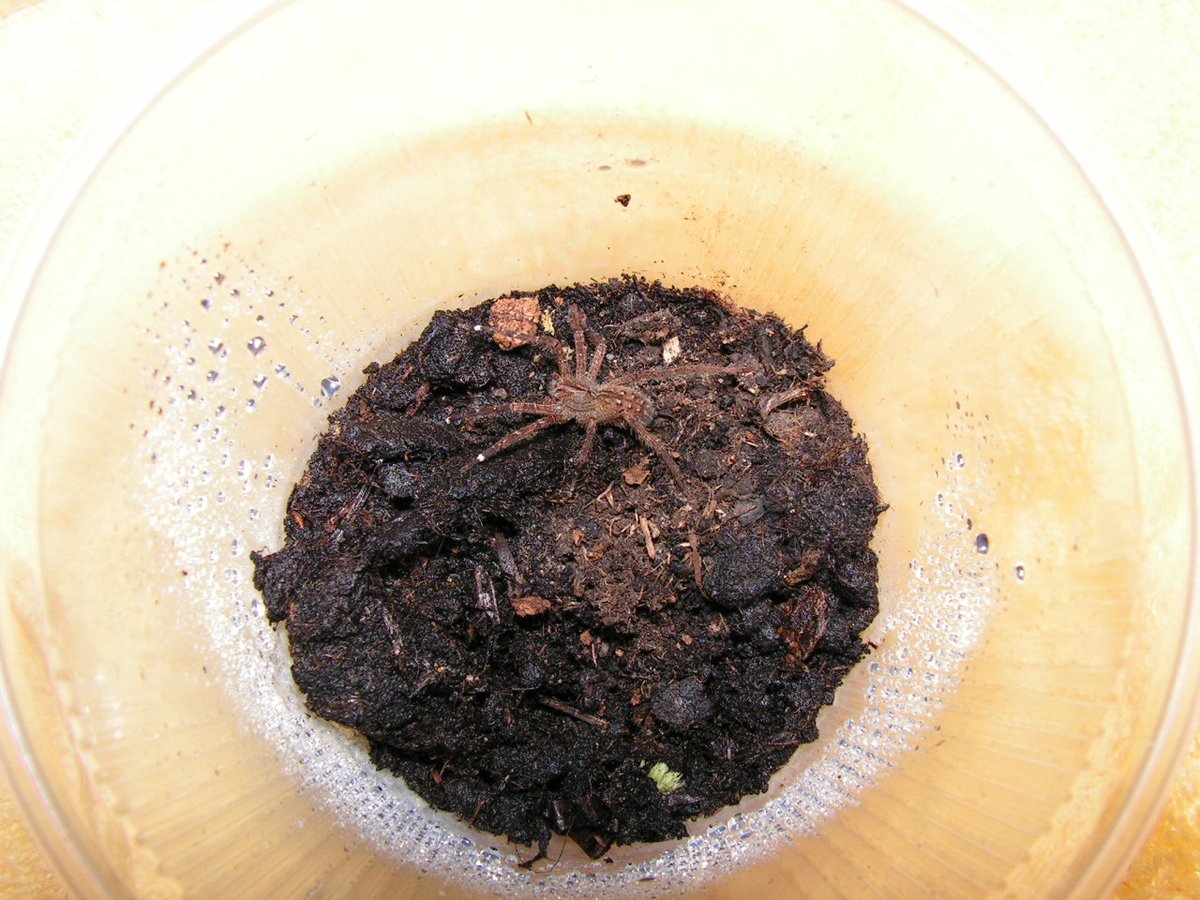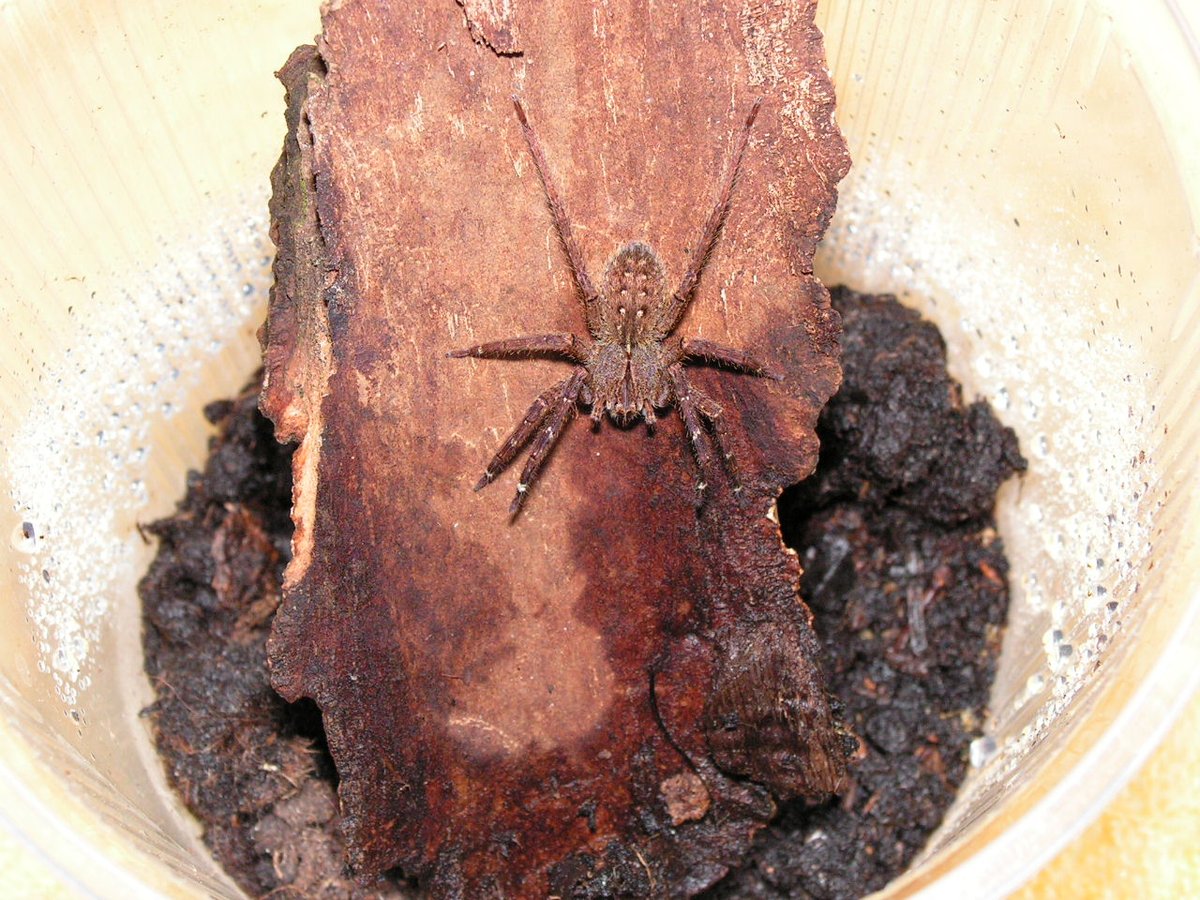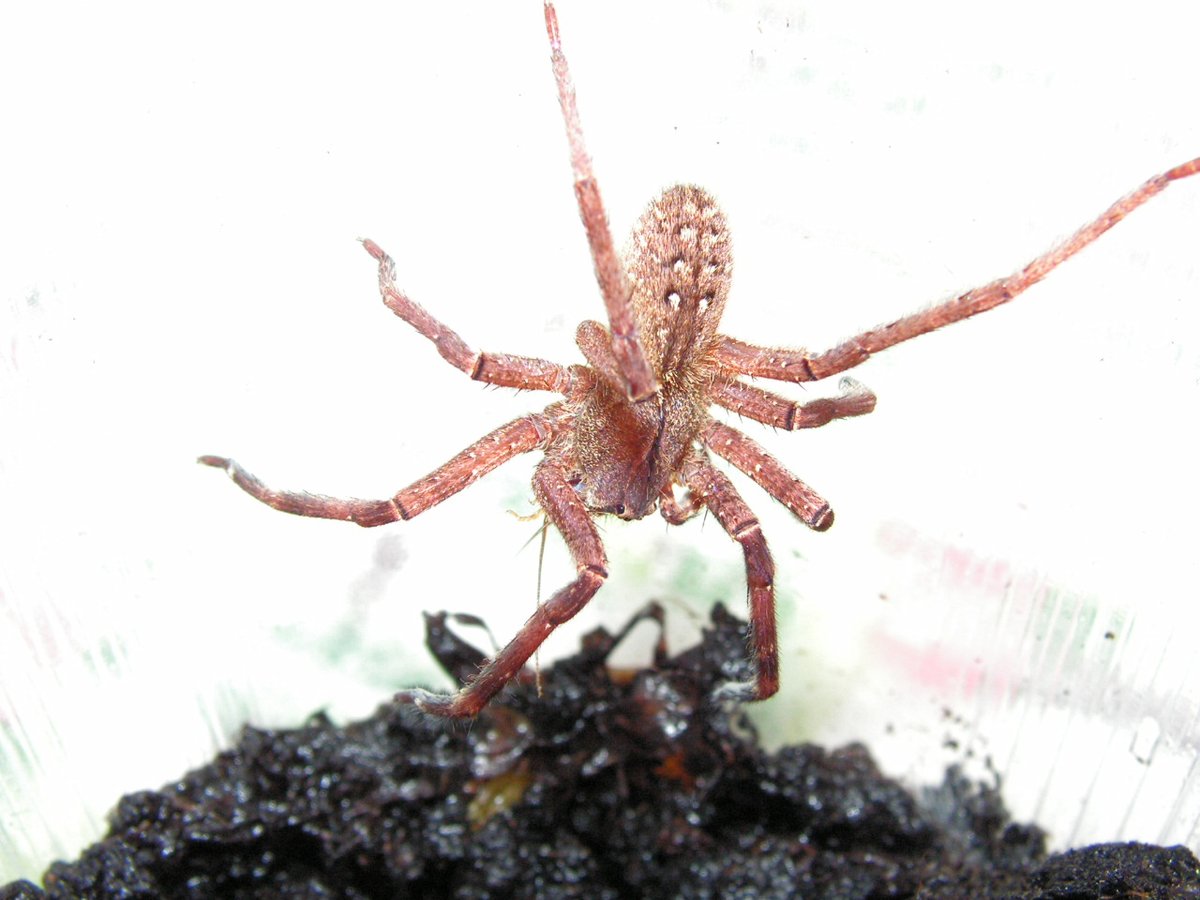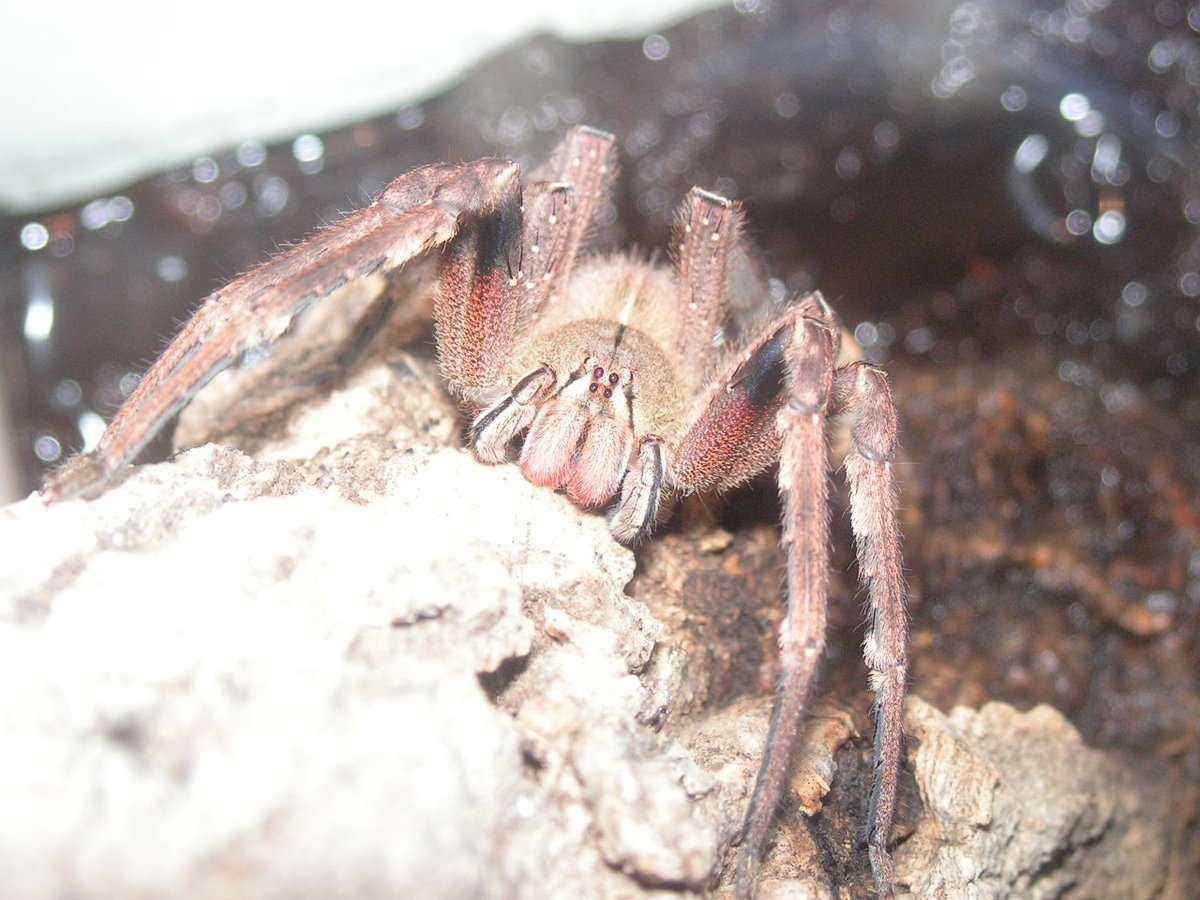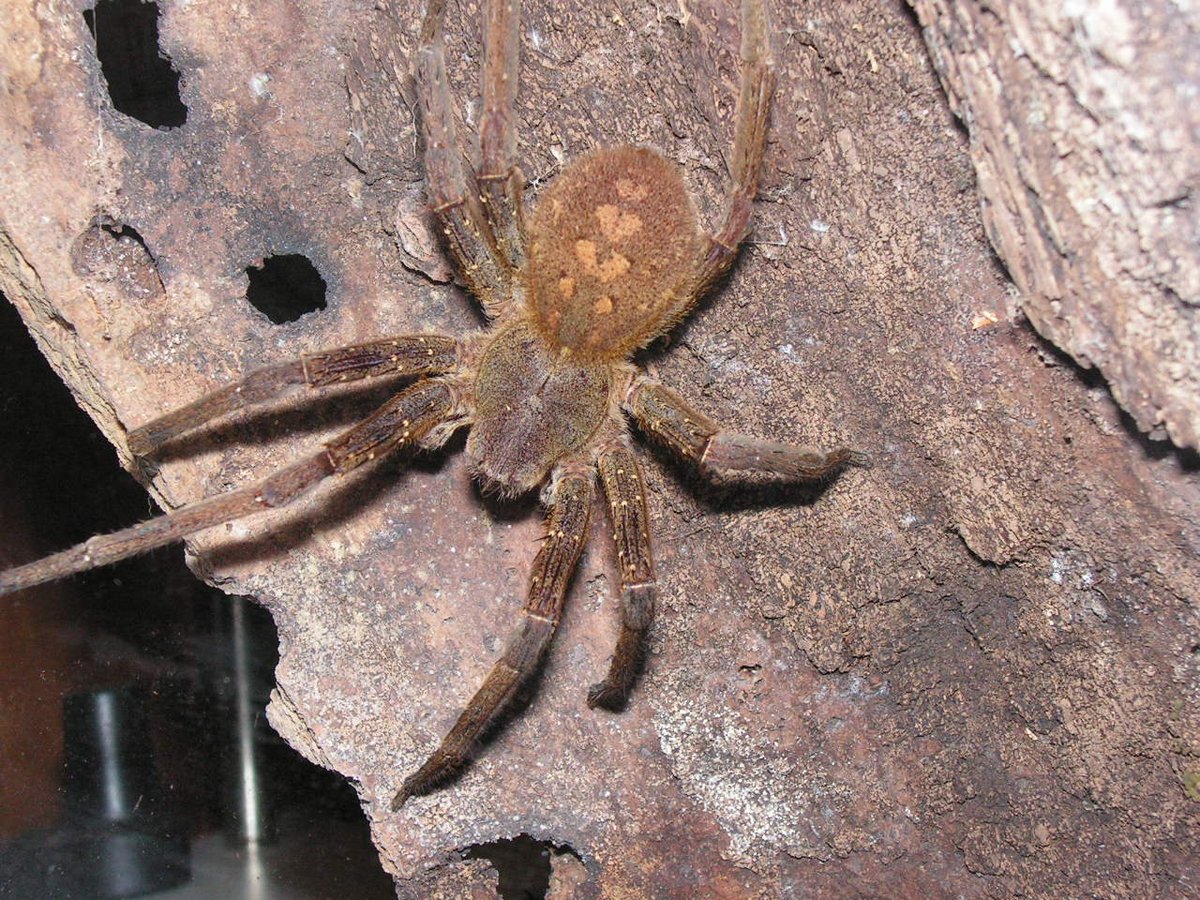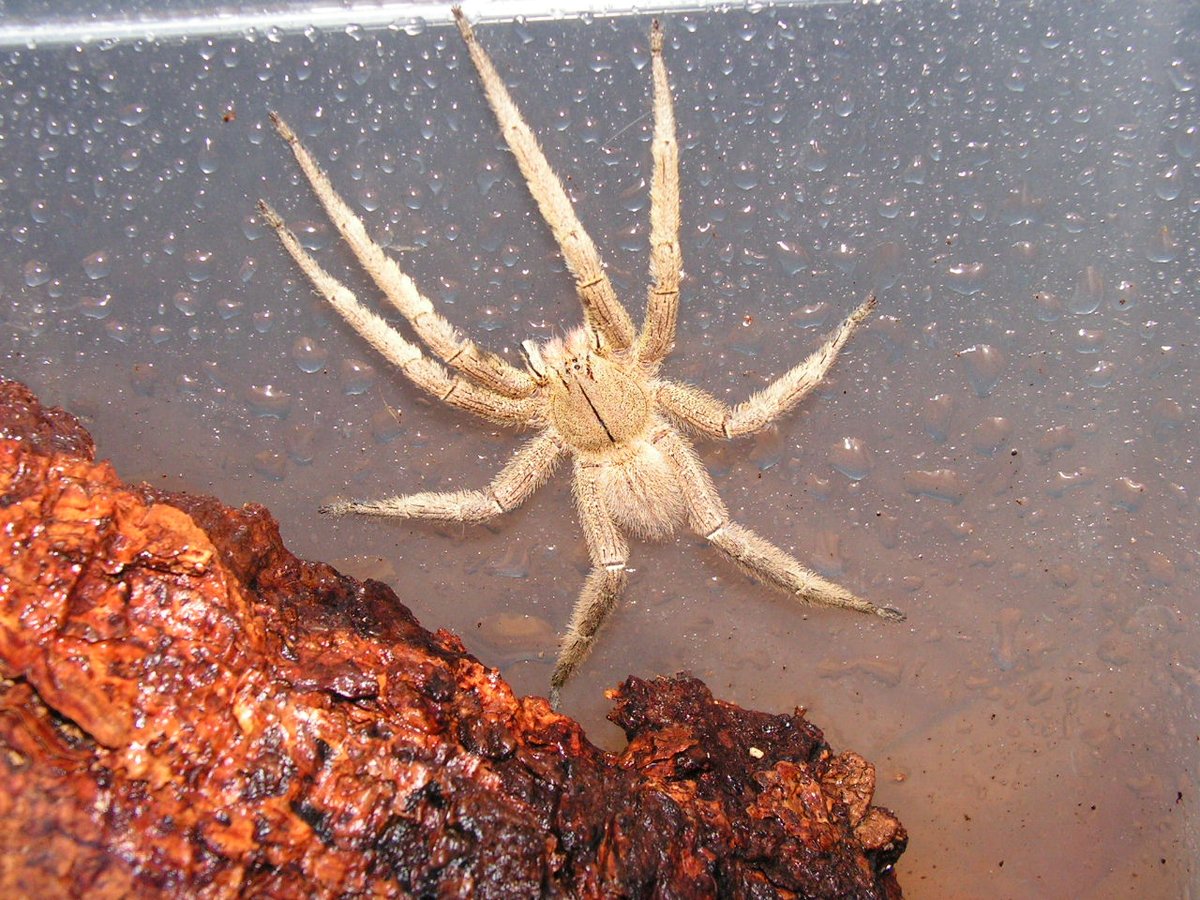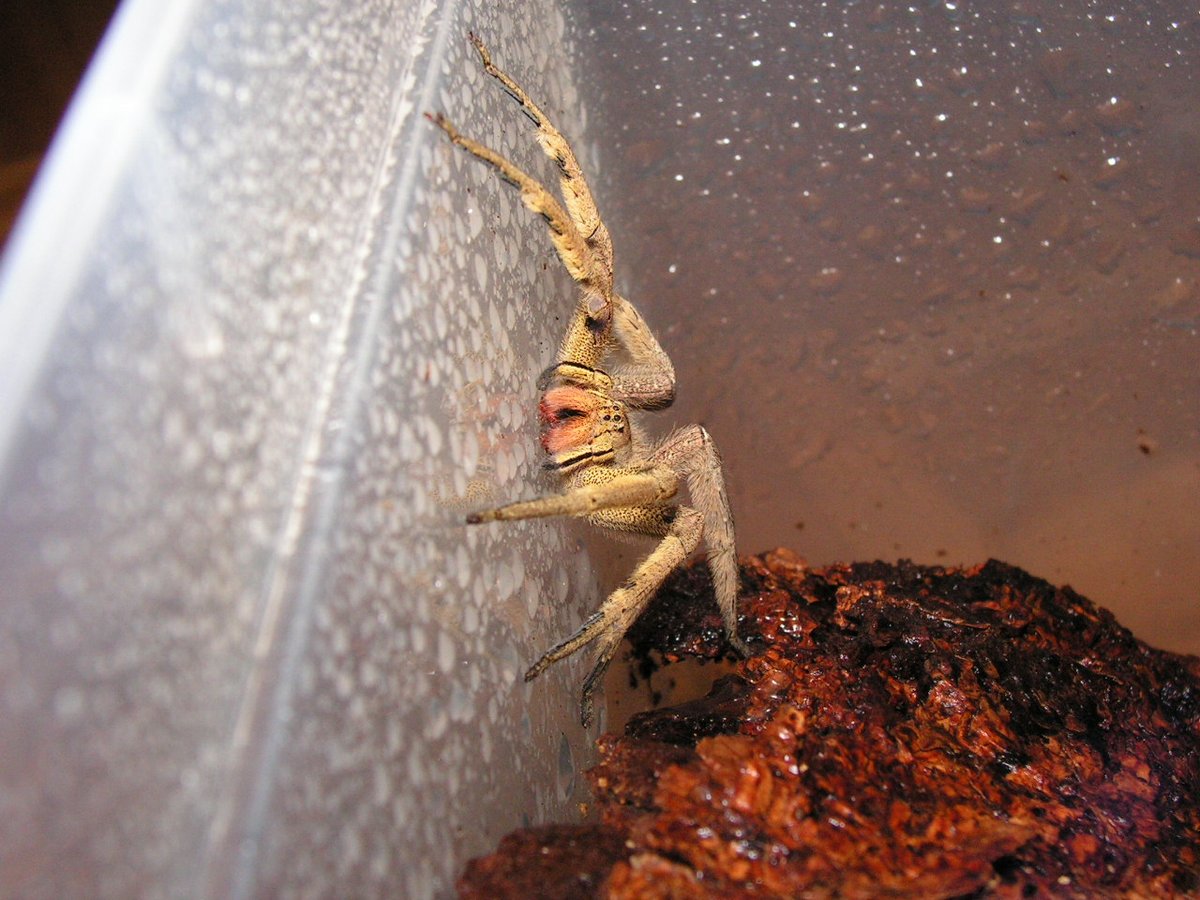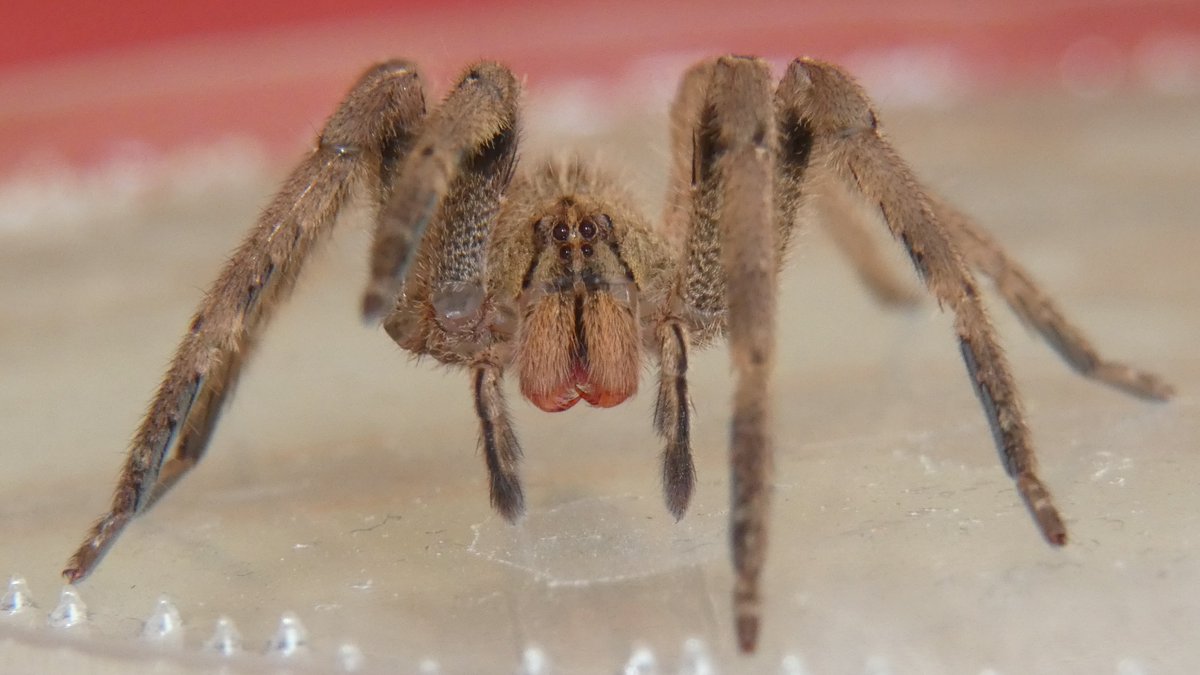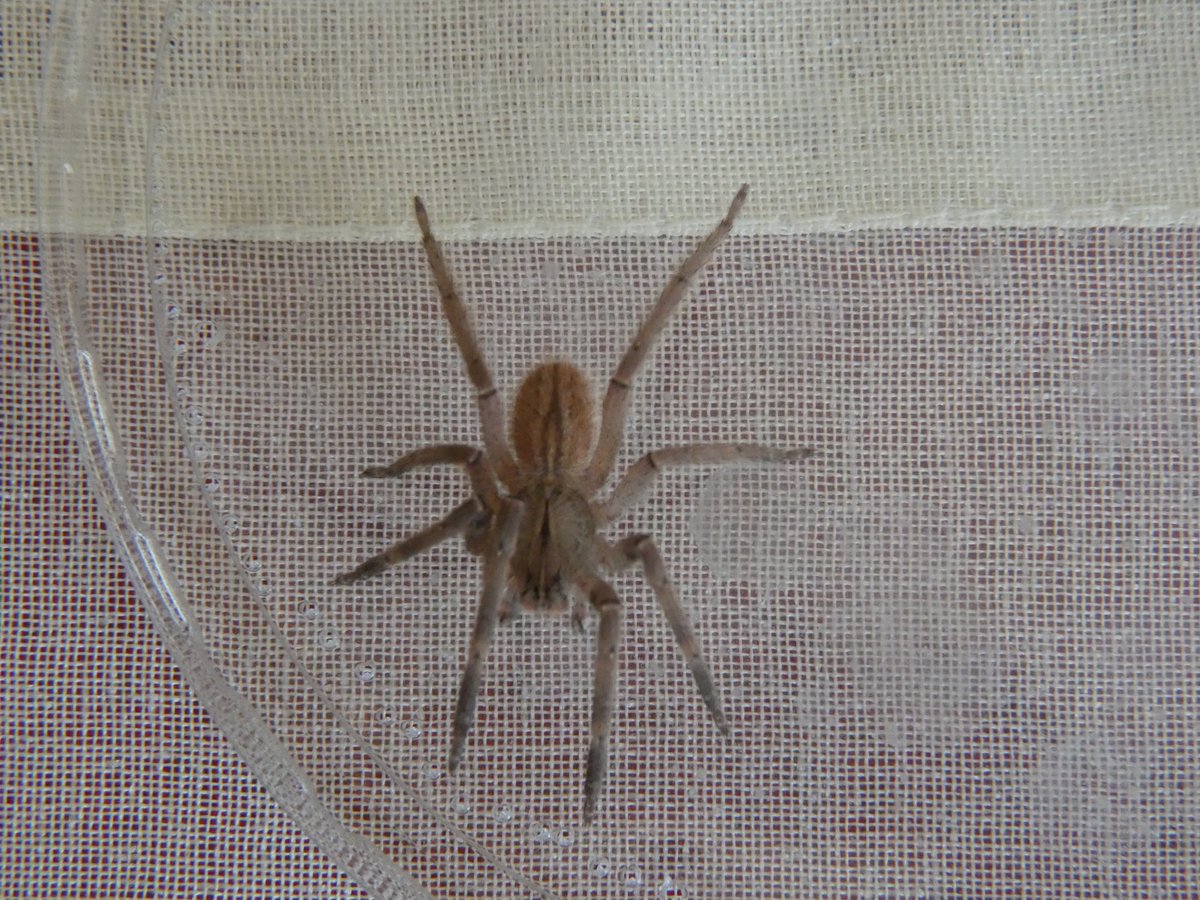Let& #39;s talk about #Phoneutria especially about the 3 species found in the Amazon area, with one of those even being distributed to Central America.
The Amazon species are: P. fera, P. reidyi and P. boliviensis. The latter is the one, which is also found (as only species of the
The Amazon species are: P. fera, P. reidyi and P. boliviensis. The latter is the one, which is also found (as only species of the
in several countries in Central America.
If one takes a look at this 3 species, one thing should be easy to recognize: the dorsal pattern of the ophistosoma. P. fera is the only species in the Amazon that has a folium pattern here.
While a quite common pattern in the genus as a
If one takes a look at this 3 species, one thing should be easy to recognize: the dorsal pattern of the ophistosoma. P. fera is the only species in the Amazon that has a folium pattern here.
While a quite common pattern in the genus as a
whole, in the Amazon species only P. fera has this. If you find a Phoneutria in that area without a folium = not P. fera.
If you find a spider without a folium elsewhere = not P. fera.
If you find a spider without a folium elsewhere = not P. fera.
Let& #39;s start something more difficult: P. boliviensis (Amazon) and P. reidyi share some features with each other: same pattern on the dorsal ophistosoma, same chelicerae setae color, same dark colored facial area, same dark colored palps.
Telling these two apart is much more
Telling these two apart is much more
difficult than to recognize P. fera.
Generally spoken, if one wants to do a "picture ID" or a "field ID" there are several body parts to consider and one must know which body parts are important determinators for which species. E.g. : femur color can be important for one species
Generally spoken, if one wants to do a "picture ID" or a "field ID" there are several body parts to consider and one must know which body parts are important determinators for which species. E.g. : femur color can be important for one species
but is rather not useful for other species.
Last important aspects are location (where has the specimen be found?) and also possible inner-species variation.
Recognizing species via pictures or in person is sometimes possible but it requires experience and - ideally - context.
Last important aspects are location (where has the specimen be found?) and also possible inner-species variation.
Recognizing species via pictures or in person is sometimes possible but it requires experience and - ideally - context.
If context and experience is lacking it& #39;s very easy to make mistakes. I speak out of my own experience here.
So far, i talked about the genus limited to the Amazon area. I now want to shift the geographical range from the Amazon to west of the Andes from southern Ecuador, through
So far, i talked about the genus limited to the Amazon area. I now want to shift the geographical range from the Amazon to west of the Andes from southern Ecuador, through
Colombia to as much north as Belize.
In this area we find only species of the genus, P. boliviensis (CA / WA).
It& #39;s important to understand, that this "morph" of P. boliviensis looks completely different to the P. boliviensis found in the Amazon.
In this area we find only species of the genus, P. boliviensis (CA / WA).
It& #39;s important to understand, that this "morph" of P. boliviensis looks completely different to the P. boliviensis found in the Amazon.
If one looks at observations of this species uploaded to @inaturalist , it seems that the Andes are an important factor in the distribution of this morph.
East of the Andes you have the mentioned 3 species, west of the Andes throughout Central America there& #39;s only this morph.
East of the Andes you have the mentioned 3 species, west of the Andes throughout Central America there& #39;s only this morph.
While looking VERY different than the P. boliviensis found in the Amazon, this morph looks VERY similar to P. fera in several aspects.
If one has no context and considers only face, palp and chelicerae color it& #39;s quite easy to get this morph mistaken for being P. fera.
If one has no context and considers only face, palp and chelicerae color it& #39;s quite easy to get this morph mistaken for being P. fera.
My personal interest in the genus is focused to these three species. My prime focus within the 3 is P. boliviensis (both morphs) and P. fera
I& #39;ve kept all of those in the past, bred several of them in the past and am actually breeding and raising P. boliviensis (Amazon) right now
I& #39;ve kept all of those in the past, bred several of them in the past and am actually breeding and raising P. boliviensis (Amazon) right now
@tea_francis @Tone_Killick @Plantecarnivore @_doctorchris @BritishSpiders @TarantulaSoc @JohananLee
Tagging all of you as you have an interest in spiders, are located in Europe and / or are keeping spiders in captive care and thus have connections to the pet keeping community.
Tagging all of you as you have an interest in spiders, are located in Europe and / or are keeping spiders in captive care and thus have connections to the pet keeping community.
This is already part of a longer thread, pls scroll up and read from the beginning.
I have reason to suspect, that wrongly ID& #39;ed Phoneutria are kept and sold in the european pet trade.
Particularly specimens sold as being P. fera, which i suspect are in fact P. boliviensis from
I have reason to suspect, that wrongly ID& #39;ed Phoneutria are kept and sold in the european pet trade.
Particularly specimens sold as being P. fera, which i suspect are in fact P. boliviensis from
Central America or western Colombia or Ecuador.
While i would shrug this generally off and in fact have reason to be quite happy about this, it& #39;s important to try to sort this out as this wrong ID could in the long turn mean the extinction for one or both species in captive care.
While i would shrug this generally off and in fact have reason to be quite happy about this, it& #39;s important to try to sort this out as this wrong ID could in the long turn mean the extinction for one or both species in captive care.
I have a bit of experience with the genus, but had to stop keeping and breeding around 2010 due to health problems.
I started keeping some spider again several years ago, but no Phoneutria. I kept a loose eye on the genus, reading scientific papers and observing what was
I started keeping some spider again several years ago, but no Phoneutria. I kept a loose eye on the genus, reading scientific papers and observing what was
available on the market, but didn& #39;t buy any.
That changed last year and i decided i wanted to give P. boliviensis another try.
Additionally to this species i also acquired (very few) specimens of P. fera and P. nigriventer. I wasn& #39;t thrilled about these two. I bred both in the
That changed last year and i decided i wanted to give P. boliviensis another try.
Additionally to this species i also acquired (very few) specimens of P. fera and P. nigriventer. I wasn& #39;t thrilled about these two. I bred both in the
past, raised them numerous times and there& #39;s not much for to learn from them now so i just decided to get a few specimens to take some pictures.
I really wanted to get hold of the P. boliviensis from Central America though. No offers and a search add i published went unanswered.
I really wanted to get hold of the P. boliviensis from Central America though. No offers and a search add i published went unanswered.
I did some recherche and found that 2 or 3 years ago there was either an import from Panama or Nicaragua or maybe even both countries where this species (next to several others) was included.
I tried to trace back that import, but no success. Not surprising as i take it for
I tried to trace back that import, but no success. Not surprising as i take it for
likely that those imports were smuggled out of those countries.
I finally found video footage of this species on youtube:
https://www.youtube.com/watch?v=pyVuJ3TEva0
Problems">https://www.youtube.com/watch... was 1.) the poster seems to believe it& #39;s P. fera and 2.) he wouldn& #39;t react to my efforts to get in touch with him.
I finally found video footage of this species on youtube:
https://www.youtube.com/watch?v=pyVuJ3TEva0
Problems">https://www.youtube.com/watch... was 1.) the poster seems to believe it& #39;s P. fera and 2.) he wouldn& #39;t react to my efforts to get in touch with him.
I shrugged this off, too. Maybe he knows what he has there and just used P. fera as a "brand" to market his video, since P. fera is a much wider recognized name than P. boliviensis.
Found some guy in the Netherlands (NL) who has bred this species early year. I inquired if the
Found some guy in the Netherlands (NL) who has bred this species early year. I inquired if the
breeding successful and - guess what - never got a reply.
Since my own breeding of P. boliviensis (Amazon) worked out i stopped my efforts to find the other morph here as i have my hands full already.
By mere coincidence i saw a short video on a FB true spider group last week.
Since my own breeding of P. boliviensis (Amazon) worked out i stopped my efforts to find the other morph here as i have my hands full already.
By mere coincidence i saw a short video on a FB true spider group last week.
Titled "P. fera" - wasn& #39;t too interested at first but got very curious after watching closely. I contacted the guy who had posted that and asked him to for some pics in different angles. He had mentioned he had offspring to sell. He supplied the pics and i suspected didn& #39;t have
P. fera but the P. boliviensis morph i was so desperately hunting for since six months. Since had only 10 slings to sell i bought all of them and thought "it& #39;s just gambling, maybe it is what i think it is and i& #39;ll be lucky". Could just be what he labeled them and i& #39;d have 10
more P. fera that i didn& #39;t need. I was reasonably sure though to invest an amount just short of 100 € and also risk shipping from NL.
The slings arrived Thursday, all alive and active, bigger than announced. Don& #39;t look like P. fera.
I& #39;m happy.
The slings arrived Thursday, all alive and active, bigger than announced. Don& #39;t look like P. fera.
I& #39;m happy.
Yesterday one of my "original" P. fera molted. I have 6 of these. They come from a very reputable German breeder that i have done business with several times in the last 10 years. One of those deals included also P. fera. This guy is breeding Phoneutria for more then 10 years.
Yesterday i took a closer look at the molted specimen and found it looked "wrong". It looks quite similar to the new "P. fera" from NL, which doesn& #39;t look like P. fera in the first place.
I compared it with my old pictures of P. fera that i bred from 2006 on.
I compared it with my old pictures of P. fera that i bred from 2006 on.
In 2005 P. fera got imported from French Guyane, they we& #39;re sold in the pet trade as P. fera.
The wild-caught specimens were handed to a biology student once they had died. That guy was taxonomically working on some other species and had expressed interest to ID the species by
The wild-caught specimens were handed to a biology student once they had died. That guy was taxonomically working on some other species and had expressed interest to ID the species by
professional methods. He had no experience with Ctenidae though. He ID& #39;ed the specimens to be P. reidyi.
The name in the pet trade got changed accordingly. This can still be found in some German and American internet boards, if one goes back to 2006-2009.
Some time later another
The name in the pet trade got changed accordingly. This can still be found in some German and American internet boards, if one goes back to 2006-2009.
Some time later another
(this time professional) biologist who also had experience with Ctenidae expressed interest to take a look at that material. The student shipped it to him and it was found to be in fact P. fera.
I mention this here to make clear that Phoneutria is NOT easy to ID by any means if
I mention this here to make clear that Phoneutria is NOT easy to ID by any means if
one hasn& #39;t experience and context.
Material from back then was P. fera (French Guayane), from 2006 on there were also P. fera coming in from Iquitos, Peru. I was personally involved in the business at this time so i speak from own experience. I bred both blood-lines (F-G & Peru)
Material from back then was P. fera (French Guayane), from 2006 on there were also P. fera coming in from Iquitos, Peru. I was personally involved in the business at this time so i speak from own experience. I bred both blood-lines (F-G & Peru)
at the time.
This species shows very little variation, regardless of origin. Variation that can sometimes be found is basically limited to basic-color, most prominently visibly in subadult / adult male specimens.
Gonna have to search for some old pics of mine...
This species shows very little variation, regardless of origin. Variation that can sometimes be found is basically limited to basic-color, most prominently visibly in subadult / adult male specimens.
Gonna have to search for some old pics of mine...
Taken in 02/2006 sling from wild caught mother from Guyana. Note pattern on ophistosoma and also white mark above the tarsi on leg I & II. Was in a 500 ml box (for size reference). P. fera:
Same specimen, some molts later. Note facial pattern, easy to get this mixed up with the CA / WA P. boliviensis. Note ventral femur color! This is a determinator for P. fera.
Important for P. fera: folium on the ophistosoma already visible in very early development stages. Ventral femur of 1. leg pair brown or reddish.
Male specimens seem of purple or even pink basic color if pics are taken with flash. Shows white marks above the tarsi as slings.
Male specimens seem of purple or even pink basic color if pics are taken with flash. Shows white marks above the tarsi as slings.
Some more pics and remarks on this observation i uploaded to @inaturalist : https://www.inaturalist.org/observations/35912450">https://www.inaturalist.org/observati...
Adult female P. fera, wild-caught from Peru. Pics from end 2006 / early 2007. Note clearly visible folium but otherwise duller basic color than males. Also note brown femurs in the 2. & 3. pic.
If you have - or know someone who has - P. fera with matte yellow ventral femurs and either no or a barely visible folium pattern on the ophistosoma, it should be questioned if it& #39;s indeed the species you bought it as.
There is nothing wrong with either species, both are "legit",
There is nothing wrong with either species, both are "legit",
100% Phoneutria. It also changes nothing on the risk assessment associated with keeping them in captive care, both are a "hands off" species and both are still calmer by temperament then P. nigriventer.
It is concerning though, that apparently even quite knowledgeable long time
It is concerning though, that apparently even quite knowledgeable long time
breeders are seeming to have a time recognizing what they are breeding there and thus selling it under a questionable species ID.
If this specimens are "only kept" everythings& #39;s fine. If someone should decide that he / she & #39;d like to breed this species and wants to buy a mate for
If this specimens are "only kept" everythings& #39;s fine. If someone should decide that he / she & #39;d like to breed this species and wants to buy a mate for
his / her specimens this can lead to problems, as these are two very different species.
What i want to ask all of you: spread the word and ask Phoneutria keeper you are aware of to question the ID of their P. fera. I& #39;d also like to know more of the origin of these specimens.
What i want to ask all of you: spread the word and ask Phoneutria keeper you are aware of to question the ID of their P. fera. I& #39;d also like to know more of the origin of these specimens.
As which species have they been sold? From which country where you told they came? Who ID& #39;d them and by which means?
If anyone should happen to have dead specimens it would be helpful to put them in alcohol and seek professional identification.
If anyone should happen to have dead specimens it would be helpful to put them in alcohol and seek professional identification.
To bring this to an end: pics from 2008, P. boliviensis from Costa Rica (juvenile, captive bred). Note ophistosoma pattern, light base color, striking "pink" chelicerae setae and yellow ventral femurs:
Pics from yesterday, fresh molted specimen bought from a well known German breeder in 09/2019 as 1. instar slings.
Sorry for the blurry pics, but you get the idea. Chelicerae setae suspiciously pink and note the ophistosoma pattern:
Sorry for the blurry pics, but you get the idea. Chelicerae setae suspiciously pink and note the ophistosoma pattern:
Legit P. fera found via Twitter: @TheFrankus .
Questionable P. fera found via Twitter / Youtube: @MarkTarantulas & @_doctorchris .
Take care, gals & dudes. If you should happen to have questions don& #39;t hesitate to check back.
Questionable P. fera found via Twitter / Youtube: @MarkTarantulas & @_doctorchris .
Take care, gals & dudes. If you should happen to have questions don& #39;t hesitate to check back.

 Read on Twitter
Read on Twitter